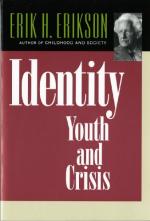
|
| Name: _________________________ | Period: ___________________ |
This test consists of 5 multiple choice questions, 5 short answer questions, and 10 short essay questions.
Multiple Choice Questions
1. What does Erikson believe is an intrinsic part of maturation?
(a) Identity crisis.
(b) Growth.
(c) Questioning one's identity.
(d) Identity formation.
2. According to Freud, what is the first stage of identity development called?
(a) Latent stage.
(b) Oral stage.
(c) Anal stage.
(d) Phallic stage.
3. As discussed by Erikson in Chapter 2, what occurs when a system either biological or social malfunctions?
(a) Confusion.
(b) Identity loss.
(c) Restart of identity formation.
(d) Pathology.
4. What does Erikson state are not constantly bolstered, an idea that is contrary to popular belief?
(a) Strong egos.
(b) The arrogant.
(c) Self conscious.
(d) Weak egos.
5. What does the success of identification during Erikson's stages of development depend on?
(a) Nothing.
(b) It is society specific.
(c) Interacting with trustworthy models.
(d) Parental support.
Short Answer Questions
1. The ________ cannot coexist with the increase in advances in a technologically led culture?
2. That does introjection mean in terms of Erikson's stages of identity development for groups other than the majority?
3. What does Freud suggest a fearless freedom of thinking is?
4. In discussing Freud's views on group identity, what does Erikson state is a major cause in identity becoming frustrating and disintegrated?
5. In Chapter 2, Foundations and Observation, during his discussion on group identity, what group of people does Erikson observe group changes to make his point?
Short Essay Questions
1. How do social scientists attempt to narrow the term identity down?
2. How does Erikson use child training to describe group identity formation?
3. Considering group identity developing, in light of Erikson's stages of development, how do individuals make group decisions in order to ease the pressures of making difficult decisions?
4. Considering Erikson's theory of identity development, how does the parent's tendency to remain stuck in adolescents affect youth's identity development?
5. What is Erikson state that he cannot accept Freud's notion that neurotic conflict is not different from normative conflict?
6. What is Erikson suggest that the development of trust or mistrust in the first age and identity development is the cornerstone of an individual's personality?
7. What was Freud's focus of theorizing?
8. What does Erikson suggest is immune to the failure of ego synthesis?
9. Why did William James refer to psychology as morbid psychology?
10. What is the role of ideologies and identity development?
|
This section contains 918 words (approx. 4 pages at 300 words per page) |

|




